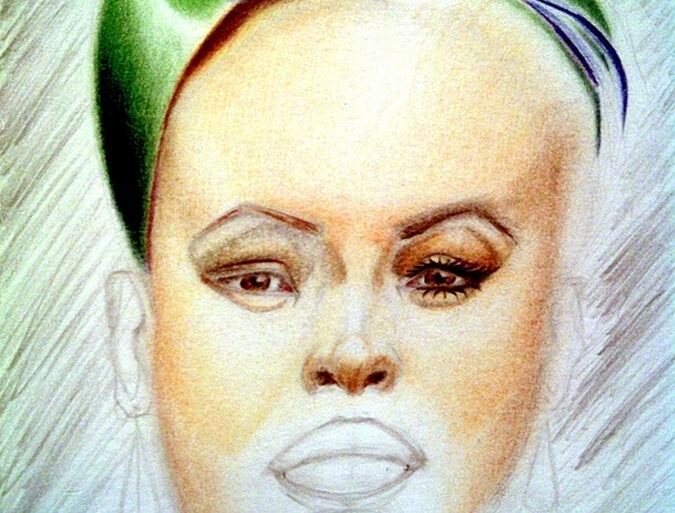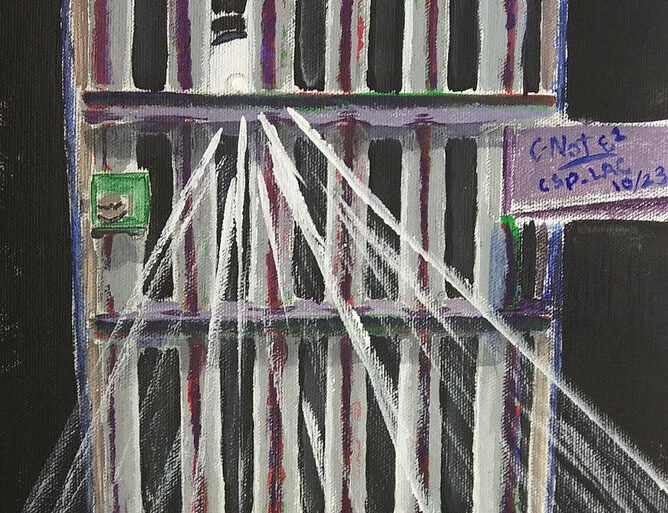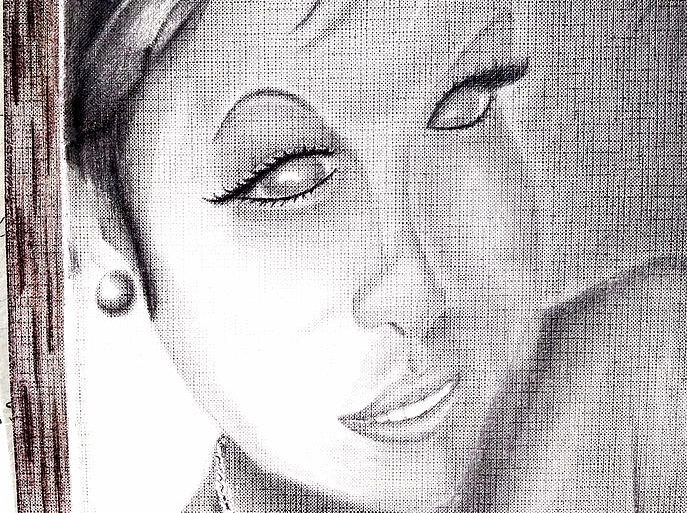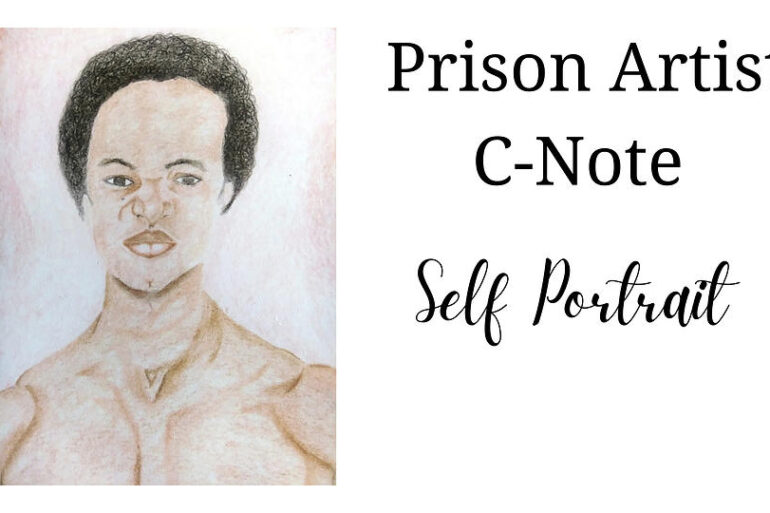Description
This Untitled piece is a study for a work of ink on pan. Pan is short for the Spanish word pañuelo. Pañuelo in English means handkerchief. These kinds of works of ball point pens, usually black, on handkerchiefs or pan are quite common in the Prisoner Art world.The scene for this work is a living room, where a mirror in back of a picture frame captures the drawn curtains from a large living room window. Near the picture frame is a metal candleholder with an unlit candle.The empty picture frame represents a photo of the artist's father and his second wife. The artist was orphaned at birthed and was adopted as an infant by an African American couple. The work was completed on a handkerchief with a portrait of the couple inside the picture frame, and sent home to his father and wife. In 2018 the artist's father died of natural causes.
Description
This Untitled piece is a study for a work of ink on pan. Pan is short for the Spanish word pañuelo. Pañuelo in English means handkerchief. These kinds of works of ball point pens, usually black, on handkerchiefs or pan are quite common in the Prisoner Art world.The scene for this work is a living room, where a mirror in back of a picture frame captures the drawn curtains from a large living room window. Near the picture frame is a metal candleholder with an unlit candle.The empty picture frame represents a photo of the artist's father and his second wife. The artist was orphaned at birthed and was adopted as an infant by an African American couple. The work was completed on a handkerchief with a portrait of the couple inside the picture frame, and sent home to his father and wife. In 2018 the artist's father died of natural causes.
Description
The Night Watchman (2023)Acrylic on canvas10 in. x 15 in.(25.4 x 38.1 cm)Donald "C-Note" Hooker"The Night Watchman" was a work specifically created for the Nov. 3 - 12, 2023, London Open Art Exhibition at The Holy Art London: The Factory, 21-31 Shacklewell Ln, London, E8 2DA.As the world's most prolific prison artist, C-Note often conveys prison bars in his visual storytelling, and "The Night Watchman" is no different.PRISONS and JAILS frequently count inmates to ensure security, maintain order, and manage the population effectively. These counts are crucial for several reasons:1. SECURITY: Regular counts prevent escapes by ensuring that all inmates are accounted for. If someone is missing, authorities can act quickly to secure the facility and locate the escapee.2. SAFETY and HEALTH: Counts also help staff ensure that inmates are safe and not in any medical distress. It's a way to make sure no one is hurt, sick, or in a situation that could threaten their well-being.3. RESOURCE MANAGEMENT: By knowing the exact number of inmates, the facility can manage resources like food, bedding, and other necessities efficiently.4. REGULATORY COMPLIANCE: Prisons and jails must comply with national and international laws and regulations, which might require regular counting to meet legal standards.As for a global graph or standard on how many times inmates are counted, this varies significantly by country and the specific policies of each institution. There isn't a universal standard, as each facility's routine is influenced by its size, security level, and operational policies. However, it's common for counts to occur multiple times a day, often during shifts changes, after movements of inmates, or during emergency situations. For specific statistics or comparative graphs, one would need to refer to studies or reports by criminal justice research organizations or governmental bodies, as these details are not typically compiled into a single global report accessible to the public.
Description
This "Untitled" was an unsolicited request from a friend and fellow prisoner. As an artist, drawing exact likenesses is not an easy task. Here, C-Note's friend felt he had missed the mark.Ever since the advent of the camera, artists have been given leeway to remove their representations as recordings of fact. Now-a-day, artists can feel comfortable in creating their representations as recordings of feelings.This work removed itself from the original photograph. Quite often in his work as a prison artist, C-Note will get portrait requests only to do them, and the fellow prisoner does not want the finished result. This has only happened when the subject to be drawn or painted was a girlfriend. Such is the life of a prison artist.It should be noted, the portrait is not framed, but the frame is a part of the drawing.
Description
This "Untitled" painting was specifically created as the result of an artist Open Call by genArts for their Third Annual Experimental Exhibition. genArts is a program of SVCreates. Silicon Valley Creates (SVCreates) is dedicated to assembling, supporting, and empowering a thriving community of arts and culture leaders who are prepared to guide and serve the region’s arts and culture community of tomorrow.Focused locally on San Jose and Silicon Valley as a whole, SVCreates still maintains important statewide connections across California and keeps an eye on the national conversations in the arts and culture sector, specifically through their connection to American for the Arts as a registered Local Emerging Leaders Network.This exhibition would feature artwork from 25+ Santa Clara County artists, capturing their voices, identities, and essences. Accepted artwork would be displayed at Crema Coffee, 1202 The Alameda, San Jose, CA 9512 from August 12 through September 28C-Note, who is a California prisoner, and does not reside in Santa Clara County, is represented by art broker Anna D. Smith, who is located in San Jose, CA. As a result of Smith's representation, she curated two billboard art installations during the pandemic, both times were solo features of artwork by prison artist C-Note, "Incarceration Nation," and "Colored Girl Warholed." C-Note and this "Untitled" work was not accepted into the exhibition.The acrylic painting was painted on a 9 in. x 12 in. canvas board. The main subject was inspired by an editorial fashion photo in a fashion. The coffee next to the plant pot, in honor of the location of the exhibition, Crema Coffee.
Prison Artist C-Note Self Portrait by Donald C-Note Hooker
Description
With the artistic direction of the artist, "Prison Artist C-Note (Self Portrait)" is a digital work for the people. Oftentimes, C-Note creates affordable work more readily available for the public, and this digital work is no exception to this rule.
Description
According to the Associated Press (AP) headline in 1998, "Calif. Prisons To Remove Weights," the AP wrote, "In a reversal of a trend dating to the 1960s, California prisons are moving to eliminate privileges such as access to weight-training equipment and tighten up appearance standards.Plans are also in the works to remove law books inmates use to challenge their confinement.``We got into the position at one juncture of providing a rather comfortable lifestyle in prison,″ said Sean Walsh, Gov. Pete Wilson’s spokesman. ``We should not allow prisoners to ride roughshod over the prisons.″The moves come as officials issue warnings about crowding in California’s 33 prisons, and as prisoners and their advocates say a tense atmosphere behind the walls is getting worse.In addition, the changes are attracting the approval of some legislators as Wilson renews his call for the Legislature to approve $1.4 billion in bonds to help finance four new prisons.One month ago, officials began enforcing new grooming standards that require men’s hair to be closely cropped, a measure that prompted at least 100 inmates at Folsom Prison to stage a hunger strike on New Year’s Day. The removal of weight-lifting gear is expected soon.``It’s all part of a comprehensive review of prison operations,″ said Tom Maddock, head of the Youth and Adult Correctional Agency. ``The core reasons are safety, security and taxpayer efficiency.″Among other steps planned this year, Maddock said prison officials plan random drug tests for inmates and will prohibit packages from being sent directly to inmates. That move is aimed at reducing drug use.A program is also afoot to require all inmates to wear white jumpsuits, instead of blue jeans and blue work shirts, thus making it more difficult for escapees to blend in, officials say.Prisoners’ rights advocates, inmates and relatives long have criticized the Department of Corrections for what they consider its punitive approach, but these latest changes are drawing criticism from within the system.``We’re going to drag them out of their drums cells and shave their heads?″ asked Don Novey, president of the California Correctional Peace Officers Association, the guards union. ``The irony of it. You’re massively overcrowded. You’re understaffed. ... It’s stupid. But it resonates with the public. We get this perception that we’re tough with the pedophiles.″Lawyers representing prisoners and other advocates are trying to block the moves, and Sen. John Vasconcellos, D-San Jose, plans to hold a hearing on the proposals.But many other legislators support the changes, and the department has broad authority to invoke emergency powers to change its rules.Matthew Jay, 30, serving 15 years to life at Solano State Prison for second-degree murder, is one of thousands of prisoners whose home is a bunk in a prison gym. Lifting weights is one of the few pastimes that relieves frustration, he said; without them tensions will rise.But he’s more worried about the potential loss of law books.``If that access is taken away, we are no longer in a prison. We are in a war camp, like a prisoner of war,″ Jay said. ``When rights are violated, we’re left with no alternative but to react. We want to prevent that.″The trend toward greater prisoners’ rights began in the 1960s, when inmates gained expanded privileges and prison officials placed more emphasis on rehabilitation.Gov. Ronald Reagan signed the single-paragraph Inmates Bill of Rights into law in 1968 and Gov. Edmund G. ``Jerry″ Brown Jr. expanded it in 1974, stating that prisoners retained all rights except those that had to be denied in order to protect prison security and public safety.By the 1990s, however, lawmakers took a different approach. The Legislature passed new sentencing laws and watered down the Inmates Bill of Rights. The statute now limits inmates’ rights generally to those required by the more restrictive federal laws.California prisons had been under a 1972 federal court order to maintain full law libraries. Citing a 1996 U.S. Supreme Court decision allowing prisons to limit law libraries, the state Department of Corrections persuaded U.S. District Judge Susan Illston in San Francisco to lift the 1972 injunction, opening the way for the department to remove most law books."According to the California Legislative Analyst's Office, "As of January 31, 2000 state prisons were at about 195 percent of their design capacity." This severe overcrowding would lead to a 2011 decision by a conservative US Supreme Court to order California to release 30,000 prisoners, because of its extreme overcrowding had horrible consequences, including deaths, in violation of the 8th Amendment to the US Constitution's Cruel and Unusual Punishment Clause. See Brown v. Platt. It was during this era of California prisoner #K94063, Donald "C-Note" Hooker's young Three Strikes sentence in 1998, that on January 1, 2000, he and other African Americans found themselves in solitary confinement after a riot with prison guards, at a prison the AP would later report on in a 2015 headline "Report: Alarming abuses seen at remote California prison," and the Washington Times headlined, "State report finds ‘culture of racism,’ alarming abuses at remote Northern California prison."These reports were based on a California Inspector General finding. It was at this time, C-Note decided to take up picture drawing, as opposed to continuing on as a poet and writer of Rap lyrics. Included in this era from 1998, during the whole of the 2000s saw the banning of prisoners being allowed to take photos at yard time. The new rules permitted only prisoners who received a visit could take photos, breaking with a long tradition of allowing prisoners to take photos of themselves and with others.Since most prisoners did not receive visits, especially at a remote prison as C-Note was from 1998 - 2011, High Desert State Prison (HDSP), he had to draw a self portrait of himself, so that the people he was newly meeting through correspondence had an idea, what he looked like.
Description
October 20th - 23rd 2021, was the 13th Annual International Prisoner's Family Conference. This year's conference was virtual. Topics included civil rights don't end at the prison gates, prison reentry, children of incarcerated parents, prison wives, and other topics. It also included a Facebook art auction of Prison art. C-Note donated a work to the conference that was specifically created for the event.Man in the Mirror, 2021, 9 in. x 12 in., Acrylic on canvas, Donald "C-Note" Hooker, features a prisoner looking at himself with a handheld mirror. What the mirror reflects back, it's not his image, but an image of him, his wife and child.









